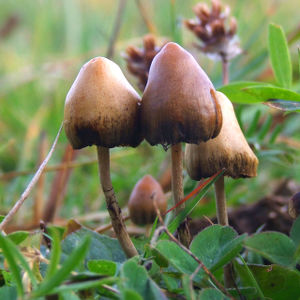We need you! Join our contributor community and become a WikEM editor through our open and transparent promotion process.
Psilocybin
From WikEM
Contents
Background
A compound found in over 200 mushrooms that has mind altering properties similar to LSD. Commonly known as "magic mushrooms" or "shrooms". The mushroom are often taken recreationally for the euphoric and hallucinogenic effects. Typically grown in the Pacific Northwest and southern regions of the United States. For a typical dose (1mg) symptoms will last 1-3 hours.
Toxicity
- Low
- 280mg/kg
- Therapeutic index of 641
Clinical Features
- Sensory/psychiatric
- Euphoria
- Visual hallucinations, synesthesia
- Lethargy, Depression
- Anxiety, agitation
- Confusion, disorientation
- Above may lead to accidental trauma
- Sympathetic effects
- Mydriasis
- Tachycardia
- Hypertension
- Nausea
- Hypotension
Differential Diagnosis
- Hypoglycemia
- TBI
- CO poisoning
- Meningitis/Encephalitis
- Opioid intoxication
- Antihistamines/Anticholinergic toxicity
Drugs of abuse
- Cocaine
- Ecstasy
- Marijuana
- Amphetamines
- Alcohol
- Synthetic cannabinoids
- Bath salts
- Heroin
- 25C-NBOMe
- Inhalant abuse
- Gamma hydroxybutyrate (GHB)
- Phencyclidine (PCP)
- Psilocybin (magic mushrooms)
Evaluation
- Clinical diagnosis
- Urine drug screen if concerned about co-ingestion
Management
- Supportive care
- Place patient in a calm and quiet environment
- Benzodiazepines for worsening tachycardia/hypertension or agitation
Disposition
- Discharge when vitals normalize and clinically sober
See Also
References
- Nichols DE. Hallucinogens. Pharmacol Ther 2004; 101:131.
- UpToDate
- van Amsterdam J, Opperhuizen A, van den Brink W (2011). "Harm potential of magic mushroom use: a review" (PDF). Regulatory Toxicology and Pharmacology. 59 (3): 423–9. doi:10.1016/j.yrtph.2011.01.006. PMID 21256914.
- Merck Index, 11th Edition, 7942
- "Comparison of acute lethal toxicity of commonly abused psychoactive substances" (PDF). Addiction. 99 (6): 686–96. doi:10.1111/j.1360-0443.2004.00744.x. PMID 15139867.
- Passie T, Seifert J, Schneider U, Emrich HM (2002). "The pharmacology of psilocybin". Addiction Biology. 7 (4): 357–64. doi:10.1080/1355621021000005937. PMID 14578010.
- "Comparison of acute lethal toxicity of commonly abused psychoactive substances" (PDF). Addiction. 99 (6): 686–96. doi:10.1111/j.1360-0443.2004.00744.x. PMID 15139867.
- Halpern JH1. "Hallucinogens and dissociative agents naturally growing in the United States." Pharmacol Ther. 2004 May;102(2):131-8.

